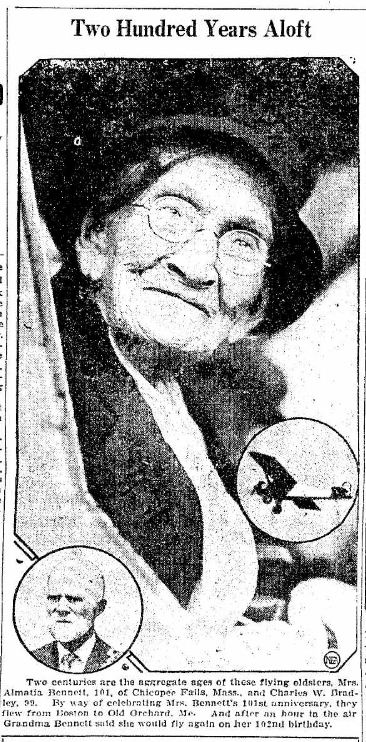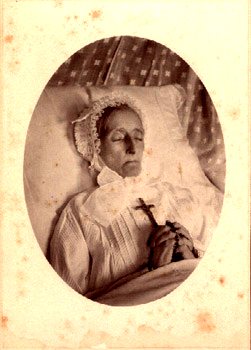
Note: This same photo of Mr. Addis ran in the newspaper several times with various articles.
JAMES A. ADDIS IS PIONEER MERCHANT, OLDEST MASON
James A. Addis enjoys the distinction of being the oldest Mason in Lawrence county and also of being the only man in New Castle who was engaged in business on Washington street an even 60 years ago.
Mr. Addis opened a confectionery and baking establishment in New Castle in April, 1847. His stand was located where the store of Jacob Cosel now stands.
He was the first man who ever packed and sold ice in New Castle and his methods were strikingly different from the ice monopoly-trust combination methods of the present day.
He was the first to open an ice cream parlor in this city and was the first to manufacture candy. His store was not as elaborate as those of the Greeks of the present day, but he didn’t lie awake endeavoring to defeat the purpose of the laws and withal he was better satisfied with his business than are the present day money seekers.
Mr. Addis remembers when Poland was the largest town across the state line and when Youngstown was proud of the number of people who stopped every day at the watering trough on what is now Federal street.
Mr. Addis is only three years short of being in the nonagenarian ranks, having been born in December of 1820.
New Castle News (New Castle, Pennsylvania) Jul 10, 1907

With two such hale and hearty 90-year-old youngsters as Joseph S. White and James A. Addis, New Castle would appear to be a health resort of no mean reputation.
New Castle News (New Castle, Pennsylvania) Dec 30, 1910
JAMES A. ADDIS PASSES AWAY IN HIS 91ST YEAR
——-
Oldest Mason in City Ends Busy Life Begun When Republic Was Young.
——-
PIONEER IN CANDY AND BAKERY TRADE
——-
He Opened First Store of Kind in New Castle and Distinctly Remembers Visit of Marquis de La Fayette to Pittsburg in 1825.
——-
James A. Addis, one of the city’s most venerable men, died at the family home, 5 Franklin avenue, very suddenly Monday evening. He was in his 91st year, and was one of the best known men in the city. He was also New Castle’s oldest merchant, as, although he had led a retired life for some years, there was not another man living who was in business in this city at the same time that Mr. Addis was a merchant.
His death was most unexpected. Despite his advanced age, Mr. Addis had been in good health until just the last few days, when he complained of feeling not so well as usual. Monday evening, about 6:30 o’clock, shortly after he had finished his evening meal, he was taken suddenly ill, and expired within a few minutes.
Born on what is now Second avenue, Pittsburg, December 23, 1820, Mr. Addis was able to tell many interesting tales of the early days of that city, and at the time of the sesqui-centennial celebration, he was interviewed by representatives of a number of Pittsburg newspapers, giving many items of interest, and telling of seeing Lafayette enter the city in 1825. When he was in a reminiscent mood, he often told of his boyhood, and retaining his faculties to the last, was a most pleasing conversationalist.
Mr. Addis was the son of Isaac Shea and Susanna Patterson Addis, and was the eldest of six children. His father moved to Pittsburg to take up his permanent residence in 1812, and resided there for many years. He had been born in Philadelphia, and first came to Pittsburg in 1809, returning to Philadelphia in 1811. He and Susanna Patterson were married in 1817. The Addis home was located on Second avenue about an eighth of a mile above Smithfield street.
James Addis’ first recollection of affairs in the early years of Pittsburg occurred when he witnessed the arrival of General Lafayette in that city in June, 1825. Mr. Addis saw the triumphal procession on Wood street, between Second and Third avenues, and stated that each feature of the event was idelibly impressed on his mind.
According to Mr. Addis there was but one iron plant, known as the Douglas mill, in active operation in Pittsburg about 1825. The locality of the plant was then called Pipetown, and was near what is now Second avenue.

Image from Wikipedia entry: Great Fire of Pittsburgh
An interesting tale of the great fire, which wiped out a portion of the business section of Pittsburg in 1846, was told by Mr. Addis. The burned territory embraced more than 50 acres and covered what is now the district bounded by Second, Ferry, Smithfiled and Diamond streets. The only building left standing in that entire territory was the one owned by George Weyman.
Mr. Addis did not retain an active impression of the government of the early days of Pittsburg, as he left the city shortly after he became of age. He remembered clearly when the famous canal was opened in 1829 between Johnstown and Pittsburg. It was an extension of the famous Juniata canal and greatly stimulated commerce in the Pittsburg district. It was in constant use until its absorption by the Pennsylvania railroad about 1855. An interesting story of a stage coach ride over the Alleghenies in 1850 as far east as Altoona was recalled. He took the stage at the old St. Charles hotel at 7 o’clock in the morning and was at Altoona at 8 the next morning, a distance of considerably more than 100 miles.
Mr. Addis was apprenticed to Robert Knox, a candymaker on Fourth street, when but a boy, and worked at that trade for some time. He attended night school in the old First ward building on the present site of the big Wabash depot. Here he obtained the rudiments of his education.
Mr. Addis stated that the coal business about 1830 was but in its infancy. Nearly all Pittsburgers burned wood. He distinctly remembered being on an Ohio river steamboat when but a child and states that there were many other passenger packets in operation at that time.
Mr. Addis came to New Castle in the year 1846, and had been a resident here much of the time since that date. He established the first confectionery store and bakery ever in the city, his place of business being located on the south side of what is now Washington street, near the Knox block. Later, he moved to the north side of the street, about the location of Mathers’ store. He was the first man in this city to open and ice cream parlor and also the first to sell oysters cooked. In those days, the supply was brought overland from Enon Valley, in the winter time, when the boats were not running.
Mr. Addis was thrice married. His first wife was Sarah Reed, a daughter of John Reed. Their children, who survive to mourn the father’s death, are Mrs. David Osborne of Buckeye, Tex.; Mrs. Sue Johnson of Covington, Ind., and Mrs. Jean A. Jones of St. Louis, Mo.

1850 census shows James A. Addis with wife, Sarah, a small child, and perhaps a sister (Reed). Occupation: Confectioner

1860 Census shows Mr. Addis, wife, Sarah, several children and his father, Isaac Addis. Occupation: Confectioner
During the Civil war, the family moved to Kansas, and there Mrs. Addis died. Some time later, Mr. Addis married again, his second wife’s death occurring in this city, after he had again taken up his residence here. His third wife was Mrs. Eliza McCandless, who survives him.

1870 census shows wife Jane (2nd wife?) and some children. Occupation: Clerk in Store

1880 census show wife Jane. Mr. Addis is working as a clerk in a hardware store.

1900 census. Mr. Addis is now married to 3rd wife, Eliza and working as a tax collector.
Mr. Addis voted for Abraham Lincoln, both times in this city. He had always retained an active interest in current happenings, and was able to give a valued opinion on many subjects.
For many years, he was a tax collector in the city, but was compelled to give up active work on account of his advancing years.
He was one of the oldest Masons in this part of the state, having been initiated into Mahoning lodge 243, F.&A.M., in 1859. On the occasion of the 50th anniversary of his initiation into the lodge, he was honored by fellow members in being presented with a handsome gift. He had always been greatly interested in Masonry, and was highly esteemed by his fellow members.

Image from Ballou’s Pictorial — More on the church at Wood St. on the City of Pittsburg website
In Pittsburg, Mr. Addis was a member of the old First Presbyterian church on Wood street. For many years, he had been a member of the First Christian church of this city. He was a man of many splendid traits of character, and his passing from the scenes of his long life brings sorrow to many.
The funeral services will be held Wednesday afternoon at 2:30 o’clock at the residence in Franklin avenue, and will be in charge of Mahoning lodge, No. 243, F.&A.M. Interment will be made in Greenwood cemetery.
New Castle News (New Castle, Pennsylvania) Jul 12, 1911

































